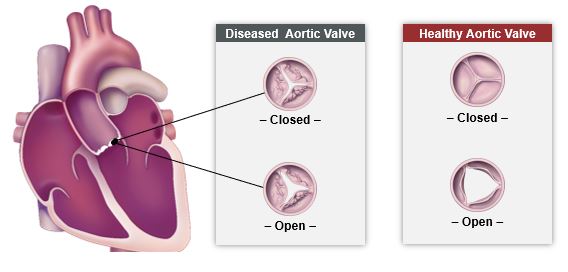What is Aortic Stenosis?
The aorta is the main artery that carries blood out of the heart to the rest of your body. Your blood flows out of your heart and into the aorta through the aortic valve. A build-up of calcium deposits on the valve can cause the valve to narrow, causing aortic stenosis.
When the leaflets on the aortic valve fail to open fully, you heart must work harder to push blood through the aortic valve to the rest of the body. Left untreated, your heart gets weaker, increasing the risk of heart failure.
People who have severe aortic stenosis have about a 50% chance of living 2 years and about a 20% chance of living 5 years, without aortic valve replacement.
Call CHI St. Vincent Valve Clinic 512-552-3400

Aortic stenosis occurs in about 2% of people over 65 years of age. It occurs more often in men than in women.
Tests to Diagnose Aortic Stenosis
Diagnosing aortic stenosis and heart valve disease may include the following tests in addition to a physical exam:
Auscultation
Your cardiologist will use a stethoscope to listen to the sounds of your heart which may detect a murmur.
Echocardiography
This is also known as an ultrasound; it uses sound waves to produce an image of your heart, which helps your doctor closely examine the aortic valve.
Cardiac catheterization (angiography)
In this test, a dye is injected into your heart through your arm or groin
to make your heart more visible on an X-ray.
Chest X-ray
An X-ray of your chest allows your doctor to check the size and shape of your heart. The X-ray image can also reveal calcium deposits on the aortic valve.
Electrocardiography (also EKG)
Your cardiologist will use a stethoscope to listen to the sounds of your heart which may detect a murmur.
Aortic Stenosis Symptoms
- Shortness of breath - Feeling winded and tired when walking or lying down
- Angina - A sensation of aching, burning, discomfort, fullness, pain, or squeezing in the chest. It may also be felt in the arms, back, jaw, neck, shoulders and throat
- Fatigue
- Fainting - A sudden and brief loss of consciousness Dizziness (after periods of inactivity)
- Rapid or irregular heartbeat Palpitations – An uncomfortable awareness of the heart beating rapidly or irregularly
These could also be symptoms of heart failure. If you have any these symptoms and have been diagnosed with heart failure, ask your doctor to also test for aortic stenosis.
Aortic Stenosis Risk Factors
- Increasing age
- High blood pressure
- Abnormal cholesterol levels
- Smoking
- Deformed aortic valve
- Family history
Aortic stenosis in patients over the age of 65 is usually caused by calcium deposits associated with aging. There are other causes as well including congenital birth defects, rheumatic fever and radiation therapy.
Explore more:

